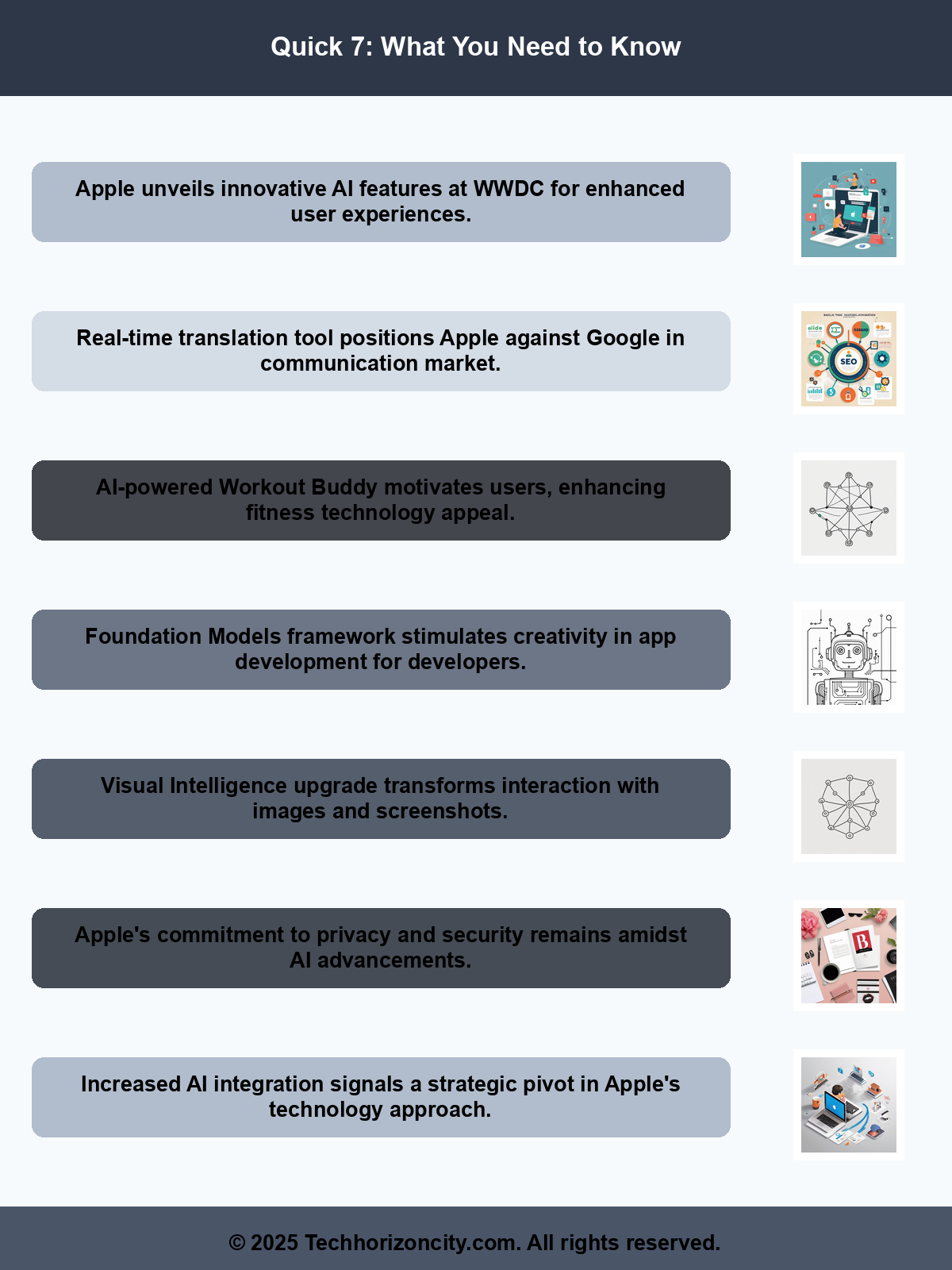Executive Summary
At the recent Worldwide Developers Conference (WWDC), Apple unveiled a suite of innovative AI features poised to enhance user experiences across its ecosystem. From real-time translation capabilities during calls to a motivational AI workout companion, these advancements signal Apple’s commitment to integrating artificial intelligence into daily life. However, as analysts point out, the tech giant faces fierce competition from industry leaders like OpenAI and Google. This article examines the implications of Apple’s latest AI offerings, their potential impact on the industry, and what the future might hold for the company in this rapidly evolving landscape.

Background Context
Artificial intelligence has become a cornerstone of technological advancement, influencing everything from user interaction to data management. As companies like OpenAI, Google, and Meta lead the charge in AI development, Apple has traditionally taken a more measured approach, prioritizing privacy and security alongside innovation. However, the landscape is changing, and the recent announcements from Apple mark a strategic pivot towards a more aggressive integration of AI capabilities.
The introduction of the Foundation Models framework allows developers to harness Apple’s proprietary AI models, potentially stimulating a new wave of creativity and utility in app development. Furthermore, the incorporation of features such as Live Translation demonstrates Apple’s intent to enhance communication across its platforms, reflecting the growing need for global connectivity in an increasingly digital world.
Analysis of Implications
The implications of Apple’s new AI features are vast. The Live Translation tool, for instance, not only facilitates seamless communication but also positions Apple as a contender in the real-time translation market, traditionally dominated by Google. This move could disrupt existing paradigms and offer users a more integrated experience when communicating across languages, especially in our diverse, globalized society.
Moreover, the introduction of the Workout Buddy, an AI-powered voice assistant designed to motivate users during exercise, opens up new possibilities in health and fitness technology. As consumers continue to gravitate towards personalized health solutions, Apple’s entry into this domain could enhance its appeal among fitness enthusiasts and casual users alike.
Furthermore, the upgrade to Visual Intelligence enables the interpretation of images and screenshots, which could transform how users interact with visual content on their devices. This feature may lead to advancements in accessibility, allowing visually impaired users to better engage with media through audio descriptions and alternative formats.
Industry Impact Assessment
Apple’s reinvigorated focus on AI could shake up the competitive landscape. As it enhances its capabilities, industry analysts are observing the company’s performance against key players like OpenAI and Google. Apple’s unique selling proposition lies in its commitment to privacy, as its AI models operate locally on devices rather than relying on cloud infrastructure. This could appeal to consumers concerned about data security, positioning Apple favorably in a market increasingly wary of privacy violations.
However, analysts like Paolo Pescatore and Francisco Jeronimo caution that Apple must accelerate its AI developments to keep pace with competitors. The tech giant’s recent upgrades are promising, but they need to translate into tangible benefits for both developers and end-users if they hope to maintain their edge in the market. The enhancements to Genmoji and Image Playground for stylized image generation further reflect Apple’s commitment to creativity, but they must be carefully executed to ensure they resonate with the user base and provide real value.
Future Outlook
Looking ahead, the trajectory of Apple’s AI strategy will be crucial to its ongoing success. As more integrated AI capabilities emerge, the company must navigate the balance between innovation and user privacy. The introduction of a Private Cloud Compute option underscores Apple’s dedication to secure data handling, a differentiator in an era where data breaches are common and trust in technology is paramount.
In the coming years, we can expect Apple to continue refining its AI offerings, perhaps expanding into other domains such as personalized education, advanced gaming experiences, and enhanced workplace productivity tools. The potential for task automation, text generation, and smart email summarization could revolutionize how users interact with their devices, making technology an even more integral part of daily life.
Conclusion with Key Takeaways
Apple’s latest announcements at WWDC signal a significant commitment to expanding its AI capabilities, with features designed to enhance communication, fitness, and visual interaction. While the company faces stiff competition from established leaders in AI, its unique focus on privacy and security may provide a competitive edge. The future of AI at Apple will likely involve not just the enhancement of existing features but also the exploration of innovative applications that can redefine user engagement in the digital age. As Apple carves out its niche in the AI landscape, the implications of these advancements could resonate across industries, shaping the future of technology and user experiences alike.
Disclaimer: This article was independently created based on publicly available information and industry analysis. While inspired by developments reported at www.wired.com, all content, analysis, and opinions expressed are original and do not reproduce copyrighted material.
For the original reporting, please visit: https://www.wired.com/story/apple-wwdc-ai-announcements/
